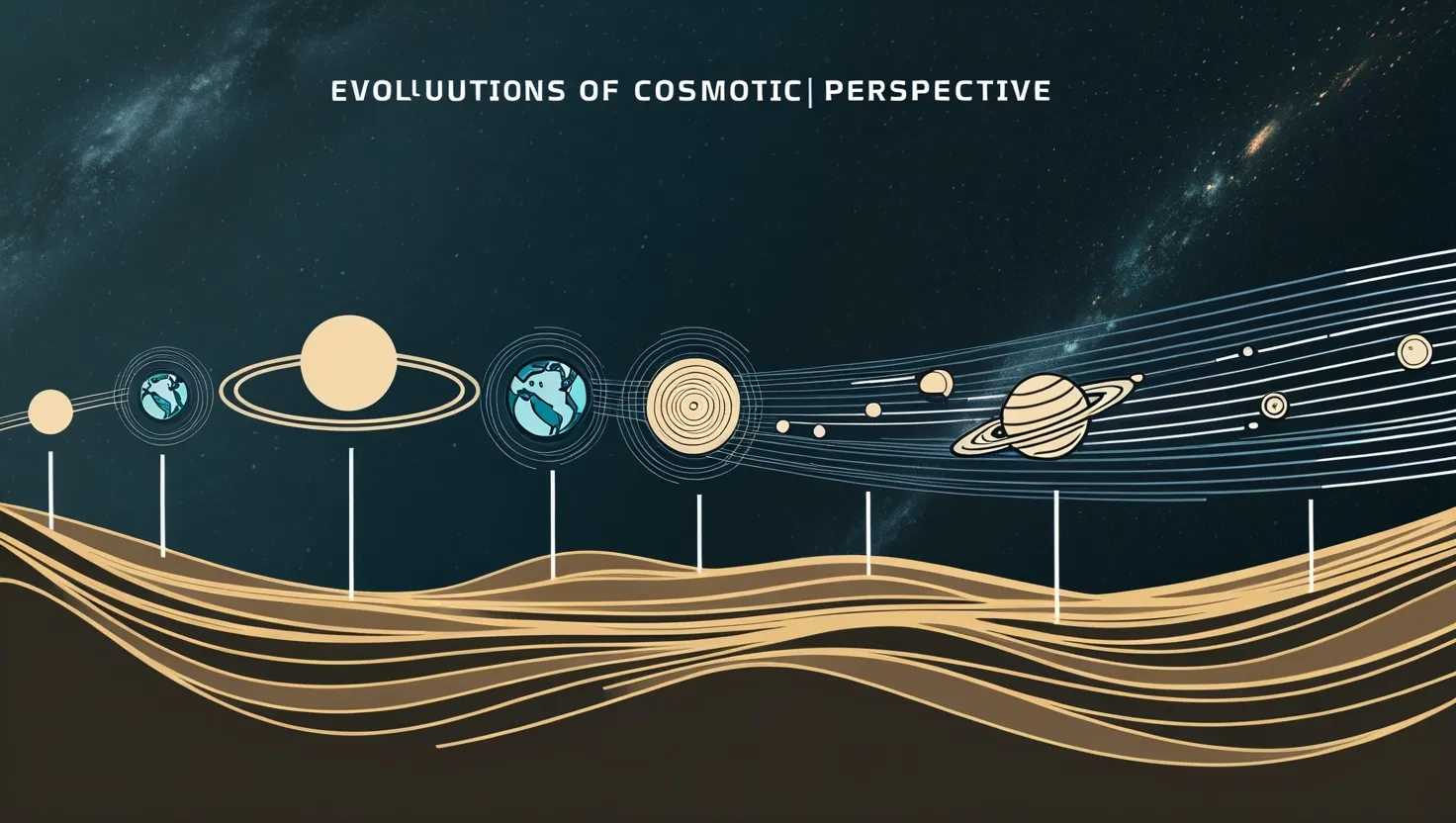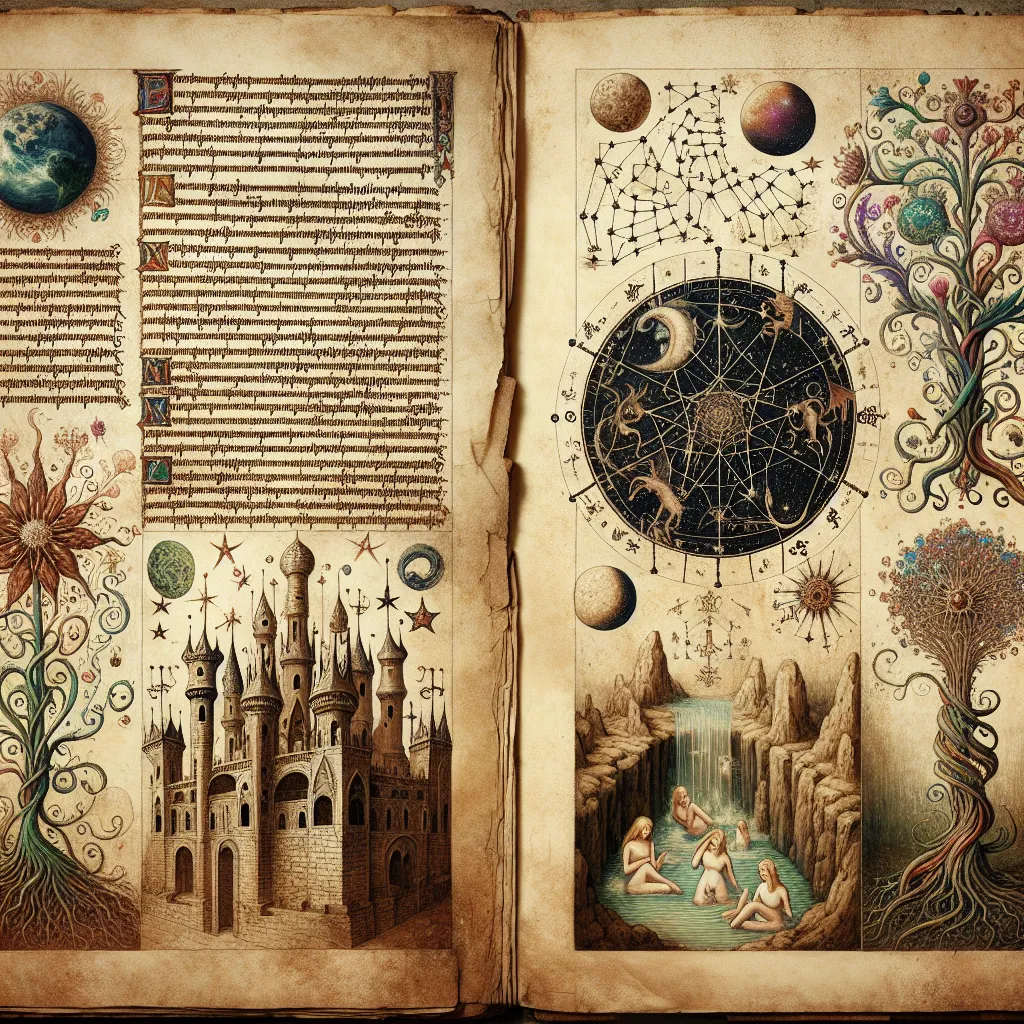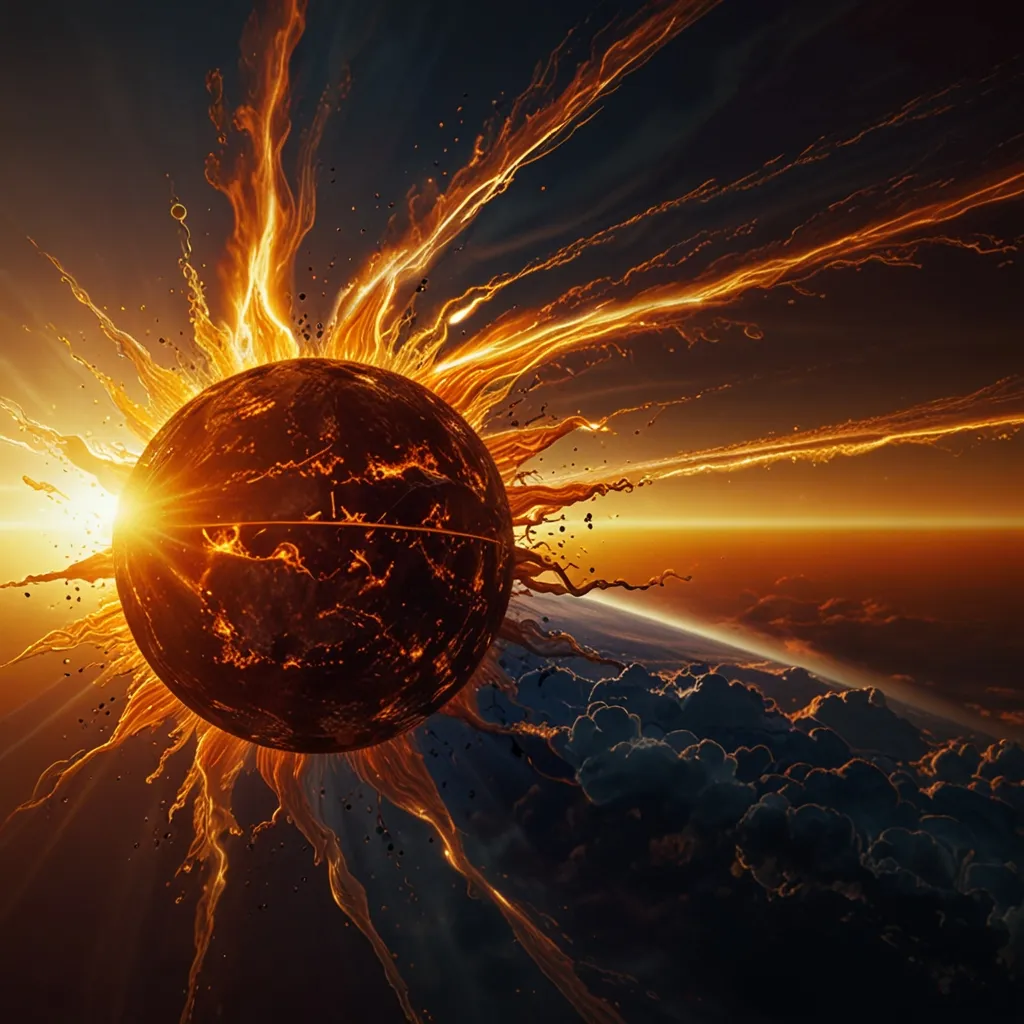Keywords: astronomical discoveries, history of astronomy, universe expansion, Copernican revolution, heliocentric model, Galileo telescope observations, Edwin Hubble discoveries, exoplanet detection, gravitational waves discovery, LIGO detector, cosmic evolution, space exploration history, planetary motion, solar system formation, Big Bang theory, redshift phenomenon, Jupiter moons discovery, Venus phases observation, Milky Way galaxy, extrasolar planets, habitable zone planets, alien life search, spacetime ripples, black hole mergers, scientific method development, telescope technology advancement, cosmic microwave background, stellar evolution, astronomical instruments, observational astronomy, theoretical physics, cosmology research, astrophysics breakthroughs, Carl Sagan quotes, Edwin Hubble telescope, pulsar planets, orbital mechanics, cosmic distance measurement, light spectrum analysis, scientific revolution impact, geocentric model refutation, astronomical observations timeline, space science milestones, cosmic perspective shift, universe age determination, stellar classification systems, planetary atmospheres study, interstellar medium research, cosmic ray detection, radio astronomy development, X-ray astronomy discoveries, infrared space telescopes, optical interferometry techniques, adaptive optics technology, CCD imaging sensors, photometry measurements, spectroscopy applications, parallax distance calculations, variable star studies, supernova observations, galaxy classification methods, dark matter research, dark energy investigations, cosmic inflation theory, multiverse hypothesis, astrobiology research, SETI programs, Drake equation calculations, Fermi paradox discussions, anthropic principle debates, fine-tuning arguments, cosmic microwave background analysis, primordial nucleosynthesis studies, stellar nucleosynthesis processes, neutron star properties, white dwarf characteristics, brown dwarf discoveries, planetary nebulae formation, globular cluster evolution, open cluster dynamics, galactic structure mapping, local group galaxies, cosmic web architecture, large scale structure surveys, redshift surveys data, luminosity distance measurements, angular diameter distances, comoving coordinates systems, Hubble constant determination, critical density calculations, omega matter values, cosmological parameters fitting, concordance model validation, precision cosmology era, observational cosmology techniques, computational astrophysics simulations, N-body simulation methods, hydrodynamic modeling approaches, magnetohydrodynamics applications, stellar atmosphere modeling, planetary formation theories, accretion disk physics, jet formation mechanisms, shock wave propagation, turbulence studies, convection processes, radiative transfer calculations, opacity calculations, equation of state derivations, nuclear reaction networks, stellar evolution codes, population synthesis models, chemical evolution tracking, metal enrichment histories, initial mass function studies, star formation rate measurements, galaxy evolution modeling, merger simulation studies, tidal interaction effects, dynamical friction processes, gravitational lensing applications, weak lensing surveys, strong lensing systems, microlensing events, transit photometry methods, radial velocity techniques, direct imaging challenges, coronagraph development, starshade technology, space interferometry missions, astrometry precision improvements, proper motion catalogs, trigonometric parallax surveys, statistical parallax methods, moving cluster analysis, main sequence fitting techniques, period luminosity relations, surface brightness fluctuations, globular cluster distances, planetary nebulae luminosity function, type Ia supernova standardization, gamma ray burst studies, gravitational wave astronomy, multi messenger astronomy, neutrino astronomy, cosmic ray physics, high energy astrophysics, particle astrophysics connections, astroparticle physics research, underground detector experiments, space based observatories, ground based telescopes, radio interferometer arrays, millimeter wave astronomy, submillimeter observations, far infrared studies, near infrared surveys, optical sky surveys, ultraviolet observations, X-ray missions, gamma ray telescopes, cosmic ray detectors, solar wind measurements, magnetosphere studies, planetary science missions, asteroid belt surveys, Kuiper belt objects, Oort cloud investigations, comet composition studies, meteorite analysis, lunar sample studies, Mars exploration missions, Venus atmosphere research, Jupiter system exploration, Saturn rings dynamics, Uranus magnetic field, Neptune moon discoveries, Pluto flyby missions, interstellar probe concepts, voyager program legacy, pioneer missions data, New Horizons discoveries, Cassini Saturn observations, Juno Jupiter mission, Parker Solar Probe measurements, Solar Orbiter mission, James Webb Space Telescope, Hubble Space Telescope legacy, Spitzer Space Telescope, Kepler mission results, TESS exoplanet survey, Gaia astrometry mission, Planck cosmic microwave background, WMAP cosmology results, Wilkinson microwave anisotropy, cosmic background explorer, infrared astronomical satellite, wide field infrared survey, two micron all sky survey, Sloan digital sky survey, large synoptic survey telescope, extremely large telescope, thirty meter telescope, giant Magellan telescope, square kilometer array, Atacama large millimeter array, very large telescope, Keck Observatory, Gemini telescopes, Subaru telescope, European southern observatory, national radio astronomy observatory, space telescope science institute, jet propulsion laboratory, NASA missions, ESA space programs, international space station, commercial space companies, private space exploration, space tourism development, asteroid mining prospects, Mars colonization plans, lunar base concepts, interstellar travel possibilities, breakthrough starshot project, search for extraterrestrial intelligence, astrobiology research programs, extremophile studies, biosignature detection methods, atmospheric characterization techniques, habitable exoplanet catalogs, potentially habitable worlds, Earth analog searches, super Earth discoveries, hot Jupiter studies, eccentric orbit planets, circumbinary planets, free floating planets, rogue planet searches, brown dwarf companions, stellar multiplicity surveys, binary star evolution, contact binary systems, cataclysmic variable stars, symbiotic star systems, Wolf Rayet stars, luminous blue variables, red supergiant stars, asymptotic giant branch, horizontal branch evolution, helium flash events, thermal pulses, s-process nucleosynthesis, r-process elements, neutron capture reactions, alpha process burning, silicon burning phase, core collapse supernovae, pair instability supernovae, hypernova explosions, long gamma ray bursts, short gamma ray bursts, kilonova events, neutron star mergers, black hole formation, stellar mass black holes, intermediate mass black holes, supermassive black holes, active galactic nuclei, quasar discoveries, blazar observations, Seyfert galaxy studies, radio galaxy properties, starburst galaxy evolution, elliptical galaxy formation, spiral galaxy structure, irregular galaxy characteristics, dwarf galaxy surveys, low surface brightness galaxies, ultra diffuse galaxies, compact group dynamics, galaxy cluster evolution, intracluster medium properties, cluster mass measurements, virial theorem applications, hydrostatic equilibrium models, X-ray cluster observations, Sunyaev Zeldovich effect, weak lensing cluster masses, strong lensing arc systems, Einstein ring formations, gravitational lens modeling, dark matter halo profiles, cold dark matter simulations, warm dark matter alternatives, sterile neutrino candidates, axion dark matter searches, WIMP detection experiments, direct detection methods, indirect detection signatures, collider dark matter studies, modified gravity theories, MOND phenomenology, f(R) gravity models, extra dimension theories, string theory cosmology, loop quantum cosmology, causal set theory, emergent gravity proposals, holographic principle applications, black hole information paradox, firewall paradox debates, complementarity principle, AdS CFT correspondence, wormhole traversability, closed timelike curves, grandfather paradox discussions, many worlds interpretation, measurement problem, quantum decoherence, observer effect, anthropic reasoning, fine tuning coincidences, multiverse typology, eternal inflation scenarios, string landscape theory, vacuum metastability, false vacuum decay, phase transition cosmology, cosmic inflation models, slow roll conditions, tensor to scalar ratio, primordial gravitational waves, cosmic microwave background polarization, B-mode detection experiments, foreground removal techniques, systematic error control, statistical analysis methods, Bayesian parameter estimation, Markov chain Monte Carlo, maximum likelihood estimation, goodness of fit testing, model selection criteria, information theory applications, machine learning astronomy, artificial intelligence applications, big data astronomy, virtual observatory resources, astronomical databases, data mining techniques, classification algorithms, regression analysis, time series analysis, Fourier transform methods, wavelet analysis, image processing algorithms, photometric calibration, astrometric reduction, proper motion measurements, radial velocity precision, stellar parameter determination, atmospheric modeling, limb darkening effects, granulation patterns, solar oscillations, asteroseismology applications, stellar activity cycles, magnetic field measurements, Zeeman effect observations, polarimetry techniques, coronagraph observations, solar wind properties, coronal mass ejections, space weather prediction, geomagnetic storm effects, aurora formation mechanisms, magnetospheric dynamics, ionospheric physics, thermospheric heating, atmospheric escape processes, planetary magnetospheres, radiation belt physics, charged particle dynamics, plasma physics applications, magnetohydrodynamic waves, Alfven wave propagation, reconnection processes, turbulent cascade, heating mechanisms, cooling processes, phase transitions, equation of state, thermodynamic equilibrium, statistical mechanics, kinetic theory, transport phenomena, diffusion processes, convective mixing, overshooting regions, rotation effects, meridional circulation, differential rotation, magnetic dynamo theory, alpha omega dynamo, flux tube emergence, sunspot cycle variations, solar maximum activity, solar minimum periods, Maunder minimum events, climate change connections, solar irradiance variations, cosmic ray modulation, heliosphere structure, termination shock, heliopause boundary, interstellar medium entry, local interstellar cloud, local bubble structure, superbubble formations, stellar wind interactions, bow shock formations, astrosphere properties, circumstellar disk evolution, protoplanetary disk structure, disk instabilities, gravitational torques, angular momentum transport, accretion rate variations, disk dispersal mechanisms, photoevaporation processes, planet migration theory, hot Jupiter formation, resonant chain systems, planetary system architectures, debris disk observations, zodiacal light studies, interplanetary dust, cosmic dust properties, dust grain formation, silicate condensation, carbonaceous compounds, organic molecule detection, complex organic chemistry, prebiotic chemistry, RNA world hypothesis, origin of life research, early Earth conditions, impact sterilization, late heavy bombardment, water delivery mechanisms, volatile inventories, atmospheric evolution, greenhouse effect calculations, runaway greenhouse, snowball Earth episodes, Gaia hypothesis, biogeochemical cycles, carbon cycle dynamics, oxygen rise events, mass extinction patterns, impact cratering, crater formation processes, shock metamorphism, meteorite classification, chondrite properties, achondrite studies, iron meteorite composition, stony iron meteorites, presolar grains, isotopic anomalies, radiometric dating, decay constant measurements, half life determinations, age determination methods, stellar nucleochronometry, galactic chemical evolution, primordial abundances, big bang nucleosynthesis, helium abundance measurements, deuterium observations, lithium problem, beryllium production, cosmic ray spallation, galactic cosmic rays, solar energetic particles, anomalous cosmic rays, interstellar pickup ions, charge state composition, isotope ratios, antiparticle searches, antimatter propulsion, exotic matter properties, negative energy densities, Casimir effect measurements, vacuum fluctuations, quantum field theory, particle physics connections, standard model extensions, grand unified theories, supersymmetry searches, extra dimension signatures, black hole evaporation, Hawking radiation, information loss problem, holographic bound, Bekenstein entropy, thermodynamic laws, second law violations, Maxwell demon, Landauer principle, computational complexity, algorithmic information theory, Kolmogorov complexity, minimum description length, data compression techniques, error correcting codes, quantum error correction, decoherence timescales, entanglement measures, Bell inequality tests, nonlocality demonstrations, hidden variable theories, pilot wave interpretation, spontaneous collapse models, objective reduction, consciousness studies, hard problem, explanatory gap, binding problem, global workspace theory, integrated information theory, orchestrated objective reduction, microtubule quantum processing, quantum biology, coherence protection, quantum transport, photosynthesis efficiency, avian navigation, magnetoreception mechanisms, quantum tunneling, proton transfer, enzyme catalysis, DNA replication fidelity, mutation rates, evolutionary algorithms, genetic programming, artificial life, cellular automata, complex adaptive systems, emergence phenomena, self organization, phase transitions, critical phenomena, scaling laws, fractal geometry, chaos theory, strange attractors, sensitive dependence, butterfly effect, deterministic chaos, nonlinear dynamics, bifurcation theory, catastrophe theory, topology applications, knot theory, algebraic topology, differential geometry, Riemannian manifolds, general relativity, spacetime curvature, geodesic equations, Einstein field equations, stress energy tensor, cosmological constant, dark energy equation of state, quintessence models, phantom energy, vacuum decay, false vacuum, cosmic strings, domain walls, monopole solutions, topological defects, inflation end, reheating process, baryogenesis mechanisms, leptogenesis, electroweak baryogenesis, CP violation, matter antimatter asymmetry, neutrino oscillations, sterile neutrinos, right handed neutrinos, see saw mechanism, neutrinoless double beta decay, lepton number violation, flavor mixing, mass hierarchy, normal hierarchy, inverted hierarchy, mass squared differences, mixing angles, CP phase, unitarity triangle, CKM matrix, flavor physics, rare decays, precision tests, loop corrections, running couplings, renormalization group, beta functions, fixed points, asymptotic freedom, confinement mechanism, QCD phase diagram, quark gluon plasma, heavy ion collisions, jet quenching, elliptic flow, perfect fluid, AdS QCD correspondence, lattice QCD, Monte Carlo simulations, finite temperature, chemical potential, phase boundaries, crossover transitions, critical endpoint, chiral symmetry breaking, spontaneous symmetry breaking, Higgs mechanism, gauge invariance, local symmetries, global symmetries, Noether theorem, conserved quantities, energy momentum conservation, angular momentum conservation, charge conservation, CPT theorem, Lorentz invariance, special relativity, time dilation, length contraction, simultaneity relativity, twin paradox, equivalence principle, general covariance, diffeomorphism invariance, coordinate freedom, gauge fixing, harmonic coordinates, synchronous gauge, conformal time, comoving coordinates, scale factor evolution, Friedmann equations, acceleration equation, continuity equation, perfect fluid, barotropic fluid, polytropic equation, adiabatic index, sound speed, Jeans length, gravitational instability, linear perturbation theory, growth factor, transfer function, matter power spectrum, correlation function, baryon acoustic oscillations, sound horizon, drag epoch, recombination era, last scattering surface, visibility function, tight coupling, Silk damping, collisional damping, free streaming, neutrino free streaming, warm dark matter, sterile neutrino, keV sterile neutrinos, X-ray line searches, structure formation, N-body simulations, particle mesh codes, tree codes, adaptive mesh refinement, hydrodynamic simulations, smoothed particle hydrodynamics, moving mesh codes, Voronoi tessellation, delaunay triangulation, oct tree structures, Friend of Friend algorithm, spherical overdensity, virial mass, concentration parameter, NFW profile, Einasto profile, subhalo abundance, satellite galaxies, missing satellite problem, too big to fail, core cusp problem, baryonic solutions, stellar feedback, supernova feedback, active galactic nucleus feedback, cosmic ray pressure, magnetic pressure, turbulent pressure, thermal pressure, ram pressure stripping, tidal stripping, harassment, strangulation, preprocessing, group environment, cluster environment, void environment, cosmic web, filament structure, node regions, wall structures, void statistics, void profiles, underdense regions, density contrast, linear bias, nonlinear bias, halo bias, galaxy bias, clustering amplitude, correlation length, galaxy surveys, photometric redshifts, spectroscopic redshifts, peculiar velocities, redshift space distortions, Kaiser effect, finger of god, Alcock Paczynski test, geometric distortions, standard rulers, standard candles, distance ladder, parallax measurements, Cepheid variables, RR Lyrae stars, red giant branch, asymptotic giant branch tip, surface brightness fluctuations, fundamental plane, Tully Fisher relation, Faber Jackson relation, type Ia supernovae, Phillips relation, color stretch corrections, host galaxy corrections, Malmquist bias, selection effects, luminosity function evolution, k corrections, evolutionary corrections, Hubble diagram, magnitude distance, distance modulus, extinction corrections, Milky Way extinction, host galaxy extinction, circumstellar extinction, intergalactic extinction, Lyman alpha forest, Gunn Peterson trough, reionization history, 21 cm cosmology, hydrogen spin flip, brightness temperature, spin temperature, excitation temperature, collisional coupling, Wouthuysen Field effect, Lyman alpha coupling, cosmic dawn, epoch of reionization, first stars, population III stars, initial mass function, stellar multiplicity, binary fraction, close binaries, contact binaries, common envelope evolution, spiral in phase, tidal locking, synchronous rotation, spin orbit coupling, Kozai mechanism, Lidov Kozai cycles, three body dynamics, Hill sphere, Roche limit, tidal disruption, mass transfer, Roche lobe overflow, wind accretion, Bondi Hoyle accretion, accretion disk formation, viscous evolution, alpha prescription, magnetorotational instability, spiral density waves, bar instabilities, secular evolution, resonant coupling, Lindblad resonances, corotation resonance, pattern speed, orbital frequency, epicyclic frequency, shear rate, vorticity, angular velocity, solid body rotation, differential rotation profile, rotation curve, flat rotation curve, declining rotation curve, rising rotation curve, maximum disk, minimum disk, dark matter halo, cuspy halo, cored halo, isothermal profile, Burkert profile, pseudo isothermal, King profile, Plummer model, Hernquist model, Jaffe model, Dehnen model, double power law, alpha beta gamma model, generalized NFW, contracted halo, adiabatic contraction, feedback effects, stellar winds, mass loss rates, terminal velocities, radiation pressure, line driving, continuum driving, dust driving, Poynting Robertson drag, YORP effect, Yarkovsky effect, orbital evolution, migration mechanisms, planet formation, planetesimal formation, streaming instability, gravitational collapse, runaway growth, oligarchic growth, late veneer, giant impact, moon formation, late heavy bombardment period, Nice model, jumping Jupiter, grand tack model, pebble accretion, type I migration, type II migration, resonant trapping, mean motion resonances, secular resonances, chaotic zones, stability analysis, symplectic integrators, Lyapunov exponents, chaos indicators, frequency analysis, proper elements, secular frequencies, fundamental frequencies, resonance overlapping, Arnold diffusion, KAM theorem, perturbation theory, averaging methods, adiabatic invariants, action angle variables, canonical transformations, Hamiltonian mechanics, Lagrangian mechanics, principle of least action, variational methods, Euler Lagrange equations, conservation laws, phase space, Liouville theorem, Poincare recurrence, mixing property, ergodic hypothesis, statistical mechanics, ensemble theory, microcanonical ensemble, canonical ensemble, grand canonical ensemble, partition function, free energy, entropy definitions, information entropy, thermodynamic entropy, Maxwell Boltzmann distribution, Fermi Dirac distribution, Bose Einstein distribution, quantum statistics, degeneracy pressure, white dwarf mass limit, Chandrasekhar limit, neutron degeneracy, neutron star mass limit, Tolman Oppenheimer Volkoff limit, general relativistic effects, frame dragging, Lense Thirring precession, geodetic precession, gravitational redshift, gravitational time dilation, equivalence principle tests, weak equivalence principle, Einstein equivalence principle, strong equivalence principle, preferred frame effects, Lorentz violation, modified dispersion relations, threshold effects, vacuum birefringence, photon splitting, axion photon mixing, chameleon fields, symmetron fields, dilaton fields, fifth force searches, inverse square law tests, Eotvos experiments, torsion balance measurements, lunar laser ranging, planetary ephemeris, timing arrays, pulsar timing, binary pulsar tests, orbital decay, gravitational wave emission, quadrupole formula, post Newtonian approximation, effective one body, numerical relativity, black hole collisions, neutron star mergers, electromagnetic counterparts, kilonova emission, r process nucleosynthesis, heavy element production, galactic chemical evolution models, stellar yields, supernova yields, asymptotic giant branch yields, white dwarf pollution, neutron star kicks, supernova remnants, pulsar wind nebulae, synchrotron emission, inverse Compton scattering, bremsstrahlung radiation, thermal emission, blackbody radiation, Planck function, Wien displacement law, Stefan Boltzmann law, Rayleigh Jeans limit, ultraviolet catastrophe, quantum mechanics, wave particle duality, uncertainty principle, complementarity principle, Copenhagen interpretation, hidden variables, Bell theorem, aspect experiments, delayed choice experiments, quantum eraser, which path information, interference patterns, double slit experiment, single photon interference, photon antibunching, squeezed light, entangled states, EPR paradox, quantum teleportation, quantum cryptography, quantum computing, qubit definitions, superposition principle, measurement postulate, wavefunction collapse, many worlds interpretation, relative state formulation, Everett interpretation, decoherence theory, consistent histories, transactional interpretation, pilot wave theory, stochastic mechanics, spontaneous localization, GRW theory, CSL model, objective collapse theories, consciousness based theories, participatory universe, Wheeler delayed choice, it from bit, digital physics, cellular automaton, discrete spacetime, loop quantum gravity, spin networks, spin foams, causal dynamical triangulation, emergent spacetime, induced gravity, sakharov gravity, thermodynamic gravity, entropic gravity, holographic principle, AdS CFT duality, gauge gravity duality, black hole complementarity, black hole information paradox, Hawking paradox, firewall argument, ER equals EPR, wormhole connections, Einstein Rosen bridge, traversable wormholes, exotic matter requirements, negative energy, Casimir energy, quantum inequalities, averaged null energy condition, quantum field theory, vacuum state, zero point energy, cosmological constant problem, hierarchy problem, naturalness problem, fine tuning, anthropic principle, multiverse theories, eternal inflation, chaotic inflation, new inflation, hybrid inflation, natural inflation, axion inflation, string inflation, brane inflation, ekpyrotic scenario, cyclic universe, pre big bang, string gas cosmology, emergent universe, bouncing cosmology, quantum bounce, loop quantum cosmology, polymer quantization, effective equations, quantum geometry, discrete geometry, planck scale physics, trans planckian problem, black hole thermodynamics, generalized second law, holographic bound, covariant entropy bound, Bekenstein bound, Landauer principle, reversible computation, quantum computation, adiabatic quantum computation, topological quantum computation, anyonic statistics, fractional statistics, quantum Hall effect, topological insulators, Majorana fermions, parafermions, non abelian statistics, braiding operations, fault tolerant quantum computation, quantum error correction codes, threshold theorem, decoherence free subspaces, dynamical decoupling, composite pulse sequences, optimal control theory, grape algorithm, machine learning applications, neural networks, deep learning, convolutional networks, recurrent networks, transformer models, attention mechanisms, generative models, variational autoencoders, generative adversarial networks, reinforcement learning, Q learning, policy gradient methods, actor critic methods, multi agent systems, game theory, Nash equilibrium, evolutionary game theory, replicator dynamics, fitness landscapes, evolutionary algorithms, genetic algorithms, evolution strategies, particle swarm optimization, simulated annealing, tabu search, constraint satisfaction, linear programming, nonlinear optimization, convex optimization, semidefinite programming, robust optimization, stochastic optimization, Bayesian optimization, Gaussian processes, kriging, surrogate models, design of experiments, response surface methodology, sensitivity analysis, uncertainty quantification, Monte Carlo methods, importance sampling, Markov chain Monte Carlo, Gibbs sampling, Metropolis algorithm, Hamiltonian Monte Carlo, nested sampling, approximate Bayesian computation, variational inference, expectation maximization, hidden Markov models, Kalman filters, particle filters, sequential Monte Carlo, bootstrap methods, jackknife, cross validation, model selection, information criteria, Akaike information criterion, Bayesian information criterion, minimum description length, probably approximately correct, statistical learning theory, VC dimension, Rademacher complexity, generalization bounds, bias variance tradeoff, overfitting, regularization, ridge regression, lasso regression, elastic net, principal component analysis, independent component analysis, factor analysis, cluster analysis, k means clustering, hierarchical clustering, density based clustering, spectral clustering, dimensionality reduction, manifold learning, multidimensional scaling, t-SNE, UMAP, autoencoder, variational autoencoder, beta VAE, disentangled representations, representation learning, self supervised learning, contrastive learning, metric learning, few shot learning, meta learning, transfer learning, domain adaptation, federated learning, differential privacy, adversarial examples, robustness, interpretability, explainable AI, LIME, SHAP, attention visualization, feature importance, causal inference, causal discovery, structural equation models, directed acyclic graphs, do calculus, instrumental variables, regression discontinuity, difference in differences, propensity score matching, randomized controlled trials, A/B testing, multi armed bandits, contextual bandits, thompson sampling, upper confidence bounds, exploration exploitation tradeoff, online learning, regret minimization, adversarial bandits, expert advice, prediction with expert advice, multiplicative weights, mirror descent, online convex optimization, stochastic bandits, linear bandits, combinatorial bandits, structured bandits, pure exploration, best arm identification, fixed budget, fixed confidence, successive elimination, median elimination, racing algorithms, hyperparameter optimization, random search, grid search, Bayesian optimization, multi fidelity optimization, population based training, evolutionary strategies, differential evolution, covariance matrix adaptation, natural evolution strategies, genetic programming, neuroevolution, NEAT algorithm, compositional pattern producing networks, indirect encoding, developmental systems, artificial embryogeny, cellular automata, Lindenmayer systems, fractal growth, self assembly, swarm intelligence, ant colony optimization, artificial bee colony, firefly algorithm, cuckoo search, bat algorithm, whale optimization, gray wolf optimizer, particle swarm optimization variants, differential evolution variants, harmony search, biogeography based optimization, invasive weed optimization, artificial immune systems, clonal selection, negative selection, danger theory, dendritic cells, natural computing, DNA computing, membrane computing, quantum computing algorithms, Shor algorithm, Grover algorithm, quantum Fourier transform, quantum phase estimation, quantum simulation, variational quantum eigensolver, quantum approximate optimization, quantum machine learning, quantum neural networks, quantum support vector machines, quantum principal component analysis, quantum k means, quantum reinforcement learning, quantum game theory, quantum walks, continuous time quantum walks, discrete time quantum walks, quantum search, amplitude amplification, quantum counting, quantum sampling, boson sampling, IQP circuits, random circuit sampling, quantum supremacy, quantum advantage, NISQ devices, variational quantum algorithms, parameter estimation, quantum sensing, quantum metrology, Heisenberg limit, quantum Fisher information, quantum Cramer Rao bound, quantum parameter estimation, quantum hypothesis testing, quantum state discrimination, minimum error discrimination, unambiguous state discrimination, quantum cloning, no cloning theorem, quantum deletion, no deleting theorem, quantum key distribution, BB84 protocol, E91 protocol, continuous variable protocols, device independent protocols, measurement device independent, quantum repeaters, quantum networks, quantum internet, quantum communication complexity, quantum fingerprinting, quantum coin flipping, quantum oblivious transfer, quantum secure multi party computation, quantum digital signatures, quantum money, quantum lottery, quantum auctions, quantum voting, quantum byzantine agreement, quantum leader election, distributed quantum computing, blind quantum computing, quantum cloud computing, quantum software, quantum programming languages, quantum circuit model, measurement based quantum computing, one way quantum computer, cluster states, graph states, stabilizer formalism, Pauli group, Clifford group, magic states, contextuality, Kochen Specker theorem, non contextuality inequalities, quantum contextuality, quantum nonlocality, CHSH inequality, GHZ states, graph coloring games, quantum pseudo telepathy, communication complexity, quantum advantages, exponential separations, polynomial separations, oracle separations, relativized complexity, interactive proofs, zero knowledge proofs, probabilistically checkable proofs, hardness of approximation, inapproximability results, unique games conjecture, planted clique, random satisfiability, phase transitions, satisfiability threshold, percolation threshold, connectivity threshold, Hamilton cycle threshold, chromatic number threshold, independence number threshold, clique number threshold, Ramsey theory, Turán problems, extremal graph theory, algebraic graph theory, spectral graph theory, expander graphs, random graphs, Erdős Rényi model, configuration model, preferential attachment, small world networks, scale free networks, power law distributions, heavy tailed distributions, Pareto distributions, Zipf law, Benford law, central limit theorem, law of large numbers, concentration inequalities, Chernoff bounds, Hoeffding bounds, McDiarmid inequality, martingales, Azuma inequality, method of bounded differences, Doob martingale, optional stopping, uniform integrability, convergence theorems, almost sure convergence, convergence in probability, convergence in distribution, weak convergence, characteristic functions, moment generating functions, cumulant generating functions, Lévy processes, Brownian motion, Wiener process, geometric Brownian motion, Ornstein Uhlenbeck process, Bessel processes, stable processes, infinitely divisible distributions, compound Poisson processes, shot noise, telegraph process, birth death processes, branching processes, Galton Watson processes, continuous time branching, immigration processes, queueing theory, Markov chains, stationary distributions, mixing times, coupling, total variation distance, spectral gap, log Sobolev inequalities, Poincaré inequalities, isoperimetric inequalities, concentration of measure, transportation cost inequalities, Wasserstein distance, optimal transport, Monge problem, Kantorovich problem, Brenier theorem, McCann theorem, displacement convexity, gradient flows, Wasserstein gradient flows, JKO scheme, diffusion equations, heat equation, Schrödinger equation, wave equation, Klein Gordon equation, Dirac equation, Maxwell equations, Einstein equations, Navier Stokes equations, Euler equations, Boltzmann equation, Vlasov equation, Fokker Planck equation, master equation, Lindblad equation, stochastic differential equations, Itô calculus, Stratonovich calculus, Malliavin calculus, rough path theory, fractional Brownian motion, long range dependence, self similarity, Hurst exponent, rescaled range analysis, detrended fluctuation analysis, multifractal analysis, wavelets, multiscale analysis, time frequency analysis, Gabor transform, windowed Fourier transform, continuous wavelet transform, discrete wavelet transform, lifting scheme, biorthogonal wavelets, compactly supported wavelets, Daubechies wavelets, Meyer wavelets, battle Lemarie wavelets, spline wavelets, ridgelets, curvelets, shearlets, contourlets, bandlets, geometric multiscale analysis, sparse representations, dictionary learning, matching pursuit, orthogonal matching pursuit, basis pursuit, compressed sensing, restricted isometry property, coherence, spark, null space property, Johnson Lindenstrauss lemma, random projections, dimensionality reduction, manifold learning, isometric embedding, conformal embedding, Nash embedding theorem, Whitney embedding theorem, differential topology, smooth manifolds, tangent spaces, cotangent bundles, differential forms, exterior derivatives, Stokes theorem, de Rham cohomology, Hodge theory, harmonic analysis, Fourier analysis, Plancherel theorem, Wiener theorem, Bochner theorem, Pontryagin duality, locally compact abelian groups, characters, dual groups, Haar measure, convolution, group algebras, representation theory, irreducible representations, character theory, Schur orthogonality, Peter Weyl theorem, compact groups, Lie groups, Lie algebras, root systems, weight spaces, highest weight representations, Cartan subalgebras, Killing form, semisimple Lie algebras, classification theorem, exceptional groups, classical groups, special unitary groups, orthogonal groups, symplectic groups, general linear groups, affine groups, Poincaré groups, conformal groups, supersymmetry algebras, graded algebras, superalgebras, Grassmann variables, fermionic fields, bosonic fields, quantum field theory, canonical quantization, path integral quantization, functional derivatives, generating functionals, correlation functions, Green functions, Feynman diagrams, perturbation theory, renormalization, regularization, dimensional regularization, Pauli Villars, cutoff regularization, renormalization group, beta functions, anomalous dimensions, critical exponents, universality, scaling laws, phase transitions, order parameters, spontaneous symmetry breaking, Goldstone theorem, Nambu Goldstone bosons, Higgs mechanism, gauge theories, Yang Mills theory, non abelian gauge theories, gauge fixing, BRST symmetry, Faddeev Popov ghosts, path integral gauge theories, lattice gauge theory, Wilson loops, confinement, asymptotic freedom, QCD, quark confinement, chiral symmetry, chiral perturbation theory, effective field theories, heavy quark effective theory, soft collinear effective theory, non relativistic QCD, low energy theorems, Goldberger Treiman relation, current algebra, PCAC, chiral anomalies, triangle anomalies, Adler Bell Jackiw anomaly, trace anomalies, conformal anomalies, scale anomalies, Weyl anomalies, holographic anomalies, inflow mechanisms, anomaly cancellation, Green Schwarz mechanism, mixed anomalies, global anomalies, discrete anomalies, parity anomalies, time reversal anomalies, CP anomalies, strong CP problem, theta vacuum, axion solution, Peccei Quinn symmetry, invisible axion, QCD axion, axion dark matter, axino, saxion, string axiverse, natural inflation, axion monodromy, N flation, assisted inflation, multi field inflation, isocurvature perturbations, non Gaussianity, equilateral template, orthogonal template, local template, running of spectral index, gravitational wave background, tensor modes, B mode polarization, E mode polarization, lensing B modes, delensing, component separation, foreground subtraction, dust emission, synchrotron emission, free free emission, spinning dust, anomalous microwave emission, CO line emission, CII line emission, Lyman alpha emission, hydrogen recombination lines, helium recombination lines, metal lines, fine structure lines, hyperfine transitions, 21 cm line, hydrogen spin flip transition






